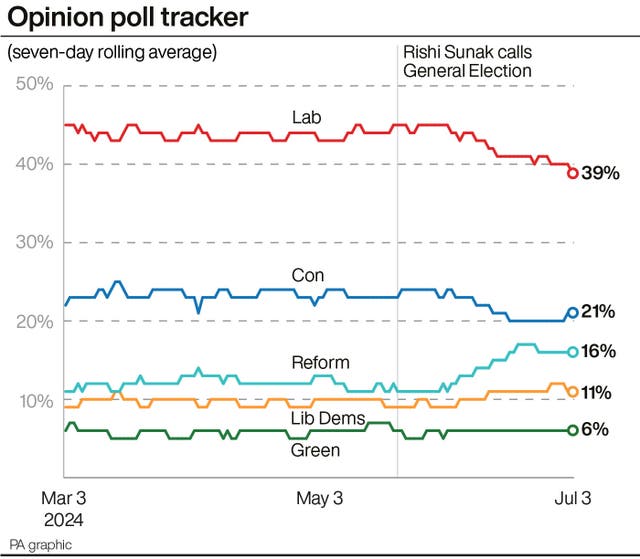Sir Keir Starmer needs a bigger swing than Sir Tony Blair’s 1997 landslide to win a majority at the General Election, with his task made more difficult by changes to constituency boundaries.
The Labour leader must achieve a swing of 12.7 points from the Conservatives to become prime minister – larger than the 10.2 point swing that brought New Labour to power in 1997 and more than double the swing at any other election since 1945.
His task is made harder by the impact of the boundary changes, the first since 2010, which are intended to ensure that constituencies have similar numbers of voters.

This left Rishi Sunak defending a notional majority of 94, compared with the 80-seat margin actually secured by Boris Johnson’s Conservatives in 2019 – although that was later diminished by by-election defeats, and MPs being suspended from the whip or defecting.
The new parliamentary constituencies were drawn up by the permanent and independent Boundary Commissions for England, Scotland, Wales and Northern Ireland, and just 77 of the 650 Commons seats were left untouched.
The boundary changes gave Mr Sunak’s hopes a modest boost, analysis by election experts Professors Colin Rallings and Michael Thrasher suggested, after they compiled notional results for what would have happened at the last general election in 2019 had it been fought on the new and changed constituencies.
“Broadly speaking this reflects a pattern where the East, South East and South West of England have gained seats reflecting the increase in electorates, and Wales has lost them, following the implementation of the new rules,” the academics said.
According to the analysis, the Conservatives would have made a net gain of seven seats from the new boundaries; Labour a net loss of two seats, the Liberal Democrats three and Plaid Cymru two.
The changes mean England is allocated 543 seats, an increase of 10; Wales will have 32 seats, a reduction of eight; Scotland will have 57, down two; and Northern Ireland remains unchanged with 18.
Despite the cut in the number of seats in Scotland, the SNP remained on 48 seats in the notional results, and there was no change in Northern Ireland, with the DUP on eight, Sinn Fein seven, SDLP on two and Alliance on one.

The four Boundary Commissions were obliged to ensure the new constituencies have an electorate within 5% of 73,392, which is the total number of voters on March 2 2020 divided by 650, the number of Commons seats.
That gave all constituencies between 69,724 and 77,062 electors with just five “island seats” exempt – Orkney and Shetland, Na h-Eileanan an Iar (Western Islands) in Scotland, Ynys Mon (Anglesey) in North Wales, and the two seats allocated to the Isle of Wight.
However some electorate figures will be several thousand higher than 77,062 because of large numbers of new registrations in recent weeks.
The Conservatives won 365 seats in the snap 2019 December election, with Jeremy Corbyn’s Labour on 203, giving Boris Johnson a majority of 80, and 162 over Labour.
Following the 2019 election, a direct swing of seven percentage points from the Conservatives was needed for Labour to become the largest party in a hung parliament, and the boundary changes meant this rose to 8.3 percentage points.
For an overall majority, Sir Keir’s 12.7 point requirement is up from 12 on the old boundaries, and any uniform swing from the Tories to Labour greater than 4.2 and less than 12.7 is likely to produce a hung parliament.
However, focusing only on the direct swing between Conservatives and Labour makes the assumption there will be no change in the share votes cast for the other parties, which is highly unlikely to be true.
For instance, a 10-point swing from the SNP to Labour would give Sir Keir 15 gains under the new boundaries, easing his path to Downing Street, according to Professors Rallings and Thrasher.
They compiled their notional results on behalf of BBC News, ITV News, Sky News and the PA news agency.

The notional results are the reason why Warrington South will be treated as a Labour defence at the election, despite it being won in 2019 by Conservative Andy Carter.
Similarly, Bury South will be treated as a Conservative defence at the election, even though its MP, Christian Wakeford, defected from the Tories to Labour halfway through the last parliament.
Under longstanding PA convention, the 77 seats with no boundary changes are treated as being held by the party at the dissolution of Parliament, so Hartlepool is a Conservative defence after the party won a by-election from Labour in 2021.
Three of the seats were held at dissolution by independent MPs, Mr Corbyn (Islington North) and Conor McGinn (St Helens North), who were both elected for Labour, and Angus MacNeil, who won Na h-Eileanan an Iar in 2019 for the SNP.
Mr Corbyn and Mr MacNeil are standing again as independents against candidates from their former parties.
You may also like: Jonathan Pie’s pre-election broadcast dubbed a ‘work of art’

